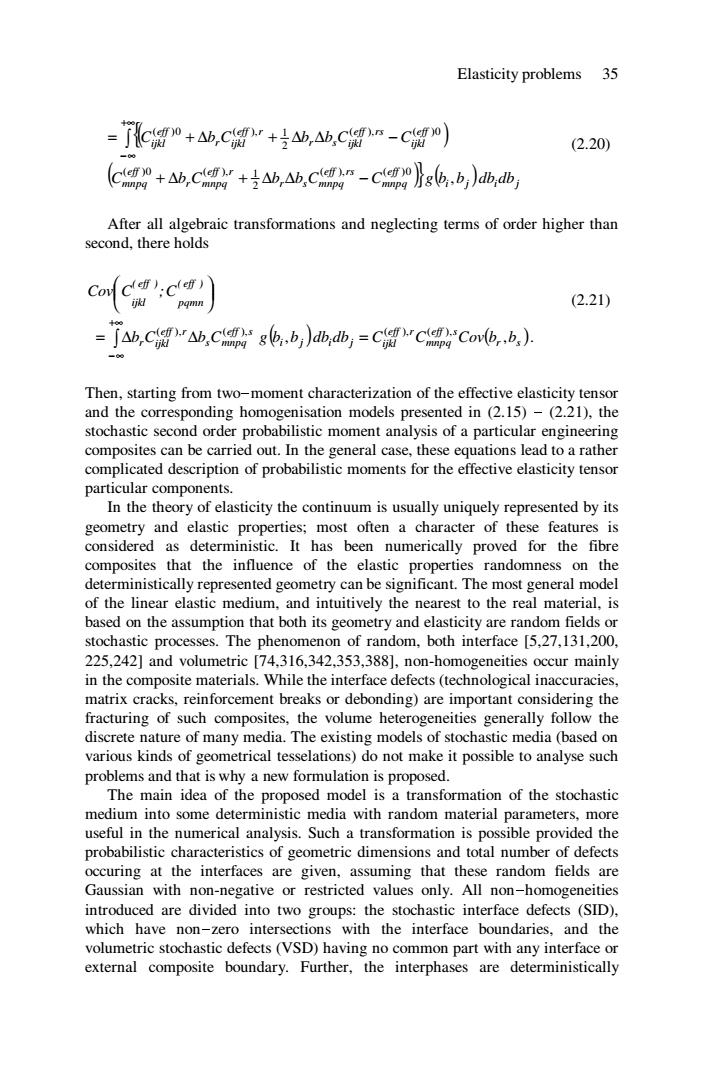正在加载图片...

Elasticity problems 35 =j了C0+,Cr+号山,Ab,Ca-CO) (2.20) 00 C0+如,Cy+Ab,ab,Ca-C}g6,b,)abab After all algebraic transformations and neglecting terms of order higher than second,there holds pqmn (2.21) JAb,CAb,Cb)db,db;=CCov(b.b.) Then,starting from two-moment characterization of the effective elasticity tensor and the corresponding homogenisation models presented in (2.15)-(2.21),the stochastic second order probabilistic moment analysis of a particular engineering composites can be carried out.In the general case,these equations lead to a rather complicated description of probabilistic moments for the effective elasticity tensor particular components. In the theory of elasticity the continuum is usually uniquely represented by its geometry and elastic properties;most often a character of these features is considered as deterministic.It has been numerically proved for the fibre composites that the influence of the elastic properties randomness on the deterministically represented geometry can be significant.The most general model of the linear elastic medium,and intuitively the nearest to the real material,is based on the assumption that both its geometry and elasticity are random fields or stochastic processes.The phenomenon of random,both interface [5,27,131,200, 225,242]and volumetric [74,316,342,353,388],non-homogeneities occur mainly in the composite materials.While the interface defects(technological inaccuracies, matrix cracks,reinforcement breaks or debonding)are important considering the fracturing of such composites,the volume heterogeneities generally follow the discrete nature of many media.The existing models of stochastic media(based on various kinds of geometrical tesselations)do not make it possible to analyse such problems and that is why a new formulation is proposed. The main idea of the proposed model is a transformation of the stochastic medium into some deterministic media with random material parameters,more useful in the numerical analysis.Such a transformation is possible provided the probabilistic characteristics of geometric dimensions and total number of defects occuring at the interfaces are given,assuming that these random fields are Gaussian with non-negative or restricted values only.All non-homogeneities introduced are divided into two groups:the stochastic interface defects (SID), which have non-zero intersections with the interface boundaries,and the volumetric stochastic defects (VSD)having no common part with any interface or external composite boundary.Further,the interphases are deterministicallyElasticity problems 35 {( ) ( )} ( ) i j i j eff mnpq eff rs r s mnpq eff r r mnpq eff mnpq eff ijkl eff rs r s ijkl eff r r ijkl eff ijkl C b C b b C C g b b db db C b C b b C C , ( ), ( )0 2 ( )0 ( ), 1 ( ), ( )0 2 ( )0 ( ), 1 + ∆ + ∆ ∆ − = ∫ + ∆ + ∆ ∆ − +∞ −∞ (2.20) After all algebraic transformations and neglecting terms of order higher than second, there holds ⎟ ⎠ ⎞ ⎜ ⎝ ⎛ ( eff ) pqmn ( eff ) ijkl Cov C ;C ( ) ( ) r s eff s mnpq eff r i j i j ijkl eff s s mnpq eff r r ijkl b C b C g b ,b db db C C Cov b ,b ( ), ( ), ( ), ( ), = ∫ ∆ ∆ = +∞ −∞ . (2.21) Then, starting from two-moment characterization of the effective elasticity tensor and the corresponding homogenisation models presented in (2.15) - (2.21), the stochastic second order probabilistic moment analysis of a particular engineering composites can be carried out. In the general case, these equations lead to a rather complicated description of probabilistic moments for the effective elasticity tensor particular components. In the theory of elasticity the continuum is usually uniquely represented by its geometry and elastic properties; most often a character of these features is considered as deterministic. It has been numerically proved for the fibre composites that the influence of the elastic properties randomness on the deterministically represented geometry can be significant. The most general model of the linear elastic medium, and intuitively the nearest to the real material, is based on the assumption that both its geometry and elasticity are random fields or stochastic processes. The phenomenon of random, both interface [5,27,131,200, 225,242] and volumetric [74,316,342,353,388], non-homogeneities occur mainly in the composite materials. While the interface defects (technological inaccuracies, matrix cracks, reinforcement breaks or debonding) are important considering the fracturing of such composites, the volume heterogeneities generally follow the discrete nature of many media. The existing models of stochastic media (based on various kinds of geometrical tesselations) do not make it possible to analyse such problems and that is why a new formulation is proposed. The main idea of the proposed model is a transformation of the stochastic medium into some deterministic media with random material parameters, more useful in the numerical analysis. Such a transformation is possible provided the probabilistic characteristics of geometric dimensions and total number of defects occuring at the interfaces are given, assuming that these random fields are Gaussian with non-negative or restricted values only. All non-homogeneities introduced are divided into two groups: the stochastic interface defects (SID), which have non-zero intersections with the interface boundaries, and the volumetric stochastic defects (VSD) having no common part with any interface or external composite boundary. Further, the interphases are deterministically